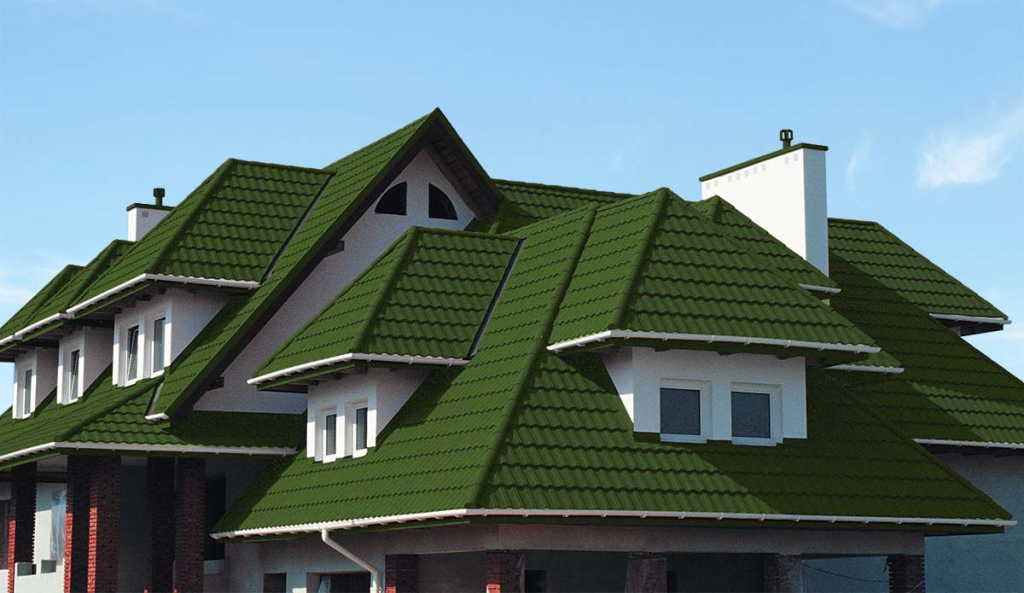
ASA (Acrylonitrile Styrene Acrylate) roof tiles are a type of synthetic roofing material known for their durability, weather resistance, and aesthetic appeal. Here are some key features and benefits of ASA roof tiles.
1.Raw materials

The main raw materials for ASA (Acrylonitrile Styrene Acrylate) roof tiles are copolymers of acrylonitrile, styrene, and acrylate. Here’s a brief explanation of these primary raw materials:
- Acrylonitrile:
- Acrylonitrile is an organic compound commonly used in the synthesis of polymers. It provides the weather resistance and chemical stability of ASA roof tiles.
- In the ASA copolymer, the presence of acrylonitrile helps enhance the material’s hardness and durability.
- Styrene:
- Styrene is an olefin, also part of synthetic polymers. In ASA, styrene contributes to certain physical properties such as transparency and a uniform surface.
- Acrylate:
- Acrylate is a category of polymers that includes various monomers with good weather resistance and UV resistance. The acrylate component in ASA helps improve the roof tiles’ UV resistance.
2.Manufacturing process

The manufacturing process of ASA (Acrylonitrile Styrene Acrylate) roof tiles involves polymerization and processing. Here are the general steps in the manufacturing process:
- Raw Material Preparation: First, the primary raw materials for ASA roof tiles, including acrylonitrile, styrene, and acrylate, need to be prepared. These raw materials may be supplied in the form of powder, granules, or other forms.
- Polymerization Reaction: In the polymerization reaction, the raw materials are mixed and exposed to appropriate catalysts and temperature conditions to initiate the polymerization process. This process results in the connection of acrylonitrile, styrene, and acrylate monomers, forming the ASA copolymer.
- Extrusion or Molding: The polymerized ASA copolymer may be extruded or formed into the desired shape of roof tiles through other molding processes, such as injection molding or extrusion. This step involves heating the ASA copolymer and pushing it through molds to shape it into tiles or other roofing forms.
- Cooling: After forming, the roof tiles need to undergo cooling to ensure they retain the desired shape and structure. Cooling can be achieved through air cooling or water cooling.
- Cutting and Shaping: Post-cooling, the roof tiles may undergo cutting and shaping processes to ensure their dimensions and appearance meet specifications.
- Surface Treatment: In some cases, the surface of the roof tiles may undergo additional treatment, such as coating. ASA roof tiles typically have an ASA surface layer, which helps enhance their UV resistance and weather resistance.
- Quality Control: Throughout the manufacturing process, quality control steps are essential. This includes testing and inspecting raw materials, semi-finished products, and the final products to ensure they meet relevant technical specifications and standards.
3.How to use

ASA (Acrylonitrile Styrene Acrylate) roof tiles are used in various construction and roofing applications due to their superior performance and characteristics. Here are common applications of ASA roof tiles:
- Residential Buildings: ASA roof tiles are suitable for residential buildings, providing an aesthetically pleasing, durable, and weather-resistant roofing option. The diverse range of colors and designs makes them a popular choice for many homeowners.
- Commercial Buildings: Commercial buildings often have high requirements for the durability and appearance of roofing materials. ASA roof tiles are widely used in commercial structures, including shopping complexes, malls, and office buildings.
- Industrial Buildings: The roofs of industrial structures need to withstand various environmental factors, including UV radiation, temperature fluctuations, and weather conditions. The weather resistance of ASA roof tiles makes them a reliable choice in industrial environments.
- Resorts and Hotels: The appearance and color choices of ASA roof tiles make them ideal for resorts, hotels, and vacation villages. Simultaneously, their weather resistance ensures long-term reliability in such environments.
- Villas and Luxury Homes: Due to the aesthetic appeal and weather-resistant properties, ASA roof tiles are often selected for villas and luxury residences to provide a sophisticated and well-designed appearance.
- Agricultural and Farm Facilities: The weather resistance and durability of ASA roof tiles make them an ideal choice for agricultural facilities, including farm buildings and livestock structures.
4.Advantage

- Weather Resistance: ASA roof tiles are designed to withstand harsh weather conditions, including UV radiation, extreme temperatures, and heavy rain. The material’s composition provides excellent resistance to fading and discoloration over time.
- Durability: ASA is a durable thermoplastic polymer that can withstand the impact of hail, wind, and other environmental stresses. This durability contributes to the long lifespan of ASA roof tiles.
- Color Stability: ASA roof tiles are known for their color stability. The material retains its original color for an extended period, ensuring that the roof maintains its aesthetic appeal over time.
- Lightweight: ASA roof tiles are relatively lightweight, making them easy to handle and install. The lightweight nature of the tiles can also reduce the overall load on the roof structure.
- Versatility: ASA roof tiles are available in a variety of profiles, shapes, and colors, providing homeowners and builders with flexibility in choosing a style that complements the overall design of the structure.
- Low Maintenance: Due to their resistance to mold, algae, and discoloration, ASA roof tiles typically require minimal maintenance. This can be advantageous for homeowners looking for roofing materials that are easy to care for.
- Recyclability: ASA is a recyclable material, which means that at the end of its life cycle, it can be processed and reused in the production of other materials.
It’s important to note that the performance and characteristics of ASA roof tiles can vary among manufacturers. When considering ASA roof tiles for your project, it’s advisable to consult with roofing professionals or suppliers who can provide information on the specific product’s features, installation guidelines, and warranty details. Additionally, local building codes and regulations should be considered to ensure compliance with standards in your region.



